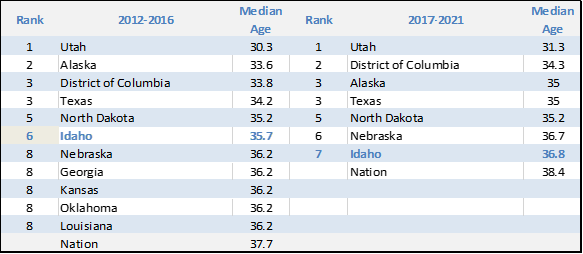Idaho 7th youngest state in the nation, swapping spots with Nebraska
Idaho continues to be one of the youngest states in the nation with a median age of 36.8 years, ranking seventh according to recently released results from the U.S. Census Bureau’s 2017-2021 American Community Survey.
This is an increase of 3.1% from the previous Census demographic survey, which covered the 2012-2016 population of the 50 states, District of Columbia and Puerto Rico. Puerto Rico’s median age grew the fastest at 9.4% and North Dakota was the slowest with no change.
Other data on age, workforce characteristics, income, migration, and housing and households reveal more information about Idaho’s populace.
Age
Nationally, the median age was 38.4 years, up slightly from its 37.7 years median age in 2012-2016.
Utah retained its ranking as the youngest state in the nation with a median age of 31.3 years. Except for North Dakota, all 50 states, the District of Columbia and Puerto Rico experienced an increase in the median age.
 Source: U.S. Census Bureau’s 2017-2021 American Community Survey.
The states and territories with the oldest populations were concentrated on the eastern side of the U.S. These territories, ranked in median age from greatest to least, were Maine (44.7 years), Puerto Rico (43.1 years), New Hampshire (43 years), Vermont (42.7 years) and West Virginia (42.6 years).
Workforce characteristics
- The average commuting time for Idahoans increased from 20.4 minutes to 21.2 minutes. Valley County residents reported the shortest median commute time across the 37 largest counties at 11.4 minutes. Boise and Lincoln counties — generally accepted as bedroom communities — reported the longest commutes at 35.3 minutes and 32.6 minutes, respectively.
- The percentage of Idahoans working from home increased from 5.9% to 9.2%.
- Three Idaho counties with popular tourist destinations reported the highest incidence of teleworking: Valley County at 15.8%, Blaine County at 14% and Teton County at 14.1%.
Income
- Idaho’s median household income increased 14.2% from $55,519 to $63,377, adjusted for inflation to 2021 dollars.
- Idaho counties with the highest median household income are Teton ($75,837), Ada ($75,115), Blaine ($71,749), Jefferson ($69,097) and Valley ($67,528).
- Only three counties experienced a decline in median household income: Elmore (-3.4%), Franklin (-0.6%) and Power (-0.3%).
- Poverty rates improved across most household types, except for female householders with no spouse present and related children under 18 years. Poverty with children in the household is highest in the rural counties of Bear Lake (81%), Bonner (56.6%), Franklin (54.9%), Gooding (72.8%), Jerome (54.4%), Lemhi (79.6%) and Washington (61.9%).
Migration
- Idaho tied with Nevada, ranking third nationally with 4.5% of the population coming from a different state. Other states/territories with high in-migration included District of Columbia (8%) and Wyoming (4.6%).
- Approximately 16% of Idaho’s population moved — either from abroad, another state, another Idaho county or within the same county — during 2017-2021. Comparatively, 13.5% of the nation’s population moved during the same period, showing more overall movement within and to Idaho.
- The median age for those moving to Idaho from another state was 28.9 years.
- At 8.3%, a significant share of Idaho’s population moved within the same county over the 2017-2021 period. The national rate was 7.4%.
- Notable states with the highest levels of movement within the same county included: Nevada at 10.6%, Arizona and District of Columbia at 10.2%, Washington at 9.4%, Alaska at 9%, Utah at 8.9%, Wyoming and Oklahoma at 8.8%, Kansas at 8.7% and Oregon at 8.5%.
Housing and households
- The number of Idaho households grew by 8.2%, an increase of 56,000 households, to 742,145.
- Idaho’s vacancy rates were in line with the lowest across the country at 0.9% for owner occupied housing and 4% for rentals. Other similarly low vacancies occurred in pockets throughout the nation.
The American Community Survey was established before the 2010 Census and released its first set of multi-year estimates in 2008. It replaced the Decennial Census Long Form to provide more timely statistics.
The survey contacts 3.5 million addresses annually covering 40+ topics and resulting in 1,140 detailed tables, 83 subject tables, five comparison profiles, narrative profiles and multiple online census tools. The survey data is used to help allocate more than $675 billion in federal funds to states and counties.
The data is available at: https://data.census.gov/.
-- end --
This Idaho Department of Labor report is 100% funded by the U.S. Department of Labor as part of an Employment and Training Administration award totaling $695,785.
|